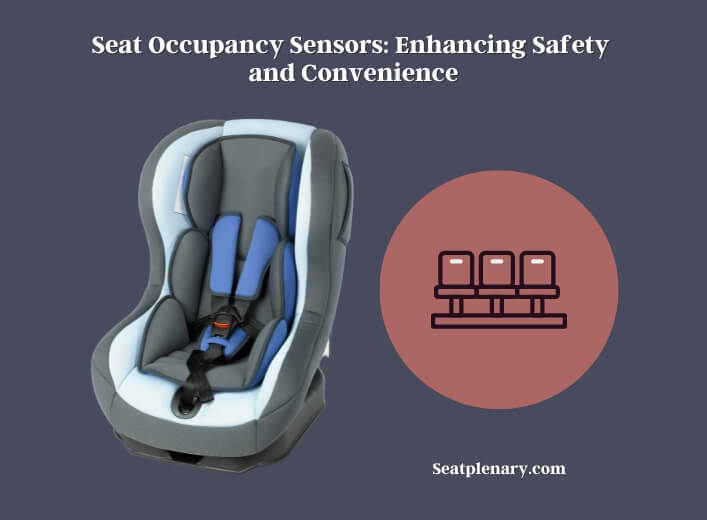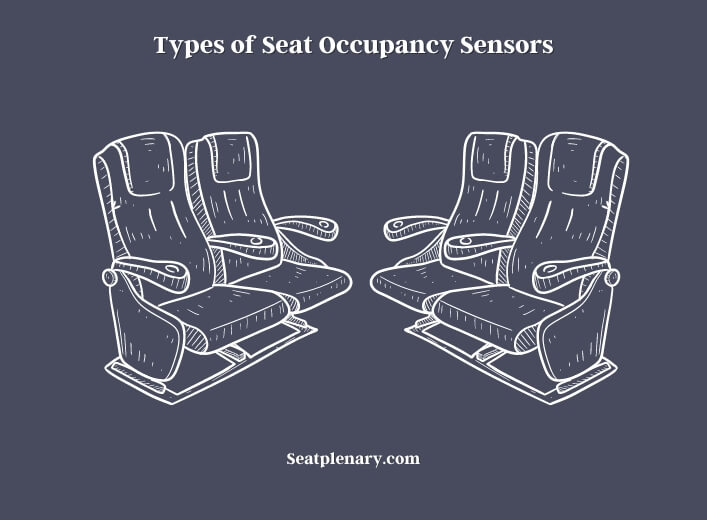Seat occupancy sensors are an essential component of modern vehicle safety systems. They are designed to detect the presence of a passenger in a vehicle seat and provide a range of benefits for both drivers and passengers. For instance, when a passenger is detected, the sensors can trigger various safety features such as seatbelt reminders and airbags, which can reduce the risk of injury in the event of an accident. Seat occupancy sensors can also enhance passenger comfort and convenience by adjusting climate control systems, entertainment systems, and other vehicle features based on the presence and position of passengers.

There are several types of seat occupancy sensors available, including weight sensors, pressure sensors, capacitance sensors, and infrared sensors. Each type has its unique advantages and disadvantages, and their effectiveness can vary depending on the situation. For example, weight sensors are effective at detecting the presence of adults, while capacitance sensors are better suited for detecting the presence of children.
Types of Seat Occupancy Sensors
Seat occupancy sensors are available in various types, each with its own unique advantages and disadvantages. These types include weight sensors, pressure sensors, capacitance sensors, and infrared sensors. Let’s take a closer look at each type and its effectiveness in different situations.
Weight Sensors
Weight sensors are the most commonly used type of seat occupancy sensor. They are designed to detect the weight of the passenger sitting in the seat and trigger various safety features accordingly. Weight sensors are effective at detecting the presence of adults, but they may not be as reliable when it comes to detecting the presence of children or small pets.
Pressure Sensors
Pressure sensors are similar to weight sensors in that they detect the presence of a passenger based on the pressure they exert on the seat. Pressure sensors are typically more sensitive than weight sensors and can detect smaller changes in pressure. This makes them more effective at detecting the presence of children and small pets, but they may also be more prone to false positives.
Capacitance Sensors
Capacitance sensors use electrical charges to detect the presence of a passenger in a seat. They work by measuring the capacitance between two conductive plates in the seat. Capacitance sensors are highly accurate and can detect the presence of both adults and children. They are also more expensive than other types of sensors.

Infrared Sensors
Infrared sensors use infrared radiation to detect the presence of a passenger in a seat. They work by emitting an infrared signal and measuring the reflection of that signal off of the passenger. Infrared sensors are highly accurate and can detect the presence of both adults and children. However, they are also the most expensive type of seat occupancy sensor.
The type of seat occupancy sensor that is most effective will depend on the specific situation and requirements of the vehicle. Weight sensors are commonly used due to their affordability, while capacitance and infrared sensors offer higher levels of accuracy but come with a higher cost. Ultimately, the choice of sensor type will depend on the specific needs and budget of the vehicle manufacturer.
Challenges and Considerations
While seat occupancy sensors offer significant benefits, they also come with a few challenges that need to be addressed to ensure their effectiveness and reliability.
Sensitivity
Seat occupancy sensors need to be sensitive enough to detect the presence of a passenger but not so sensitive that they trigger false positives. Achieving the correct balance between sensitivity and specificity can be a challenging task.
Cost
The cost of seat occupancy sensors can vary depending on the type and features. More accurate sensors, such as capacitance and infrared sensors, can be more expensive than weight and pressure sensors. The cost of the sensor must be balanced against the benefits they offer.
Compatibility
Seat occupancy sensors need to be compatible with the vehicle’s seat design and configuration. Compatibility issues can arise if the sensor is not designed to fit a specific seat type or if it interferes with the seat’s safety features, such as the airbag.
Calibration
Seat occupancy sensors need to be calibrated correctly to ensure that they provide accurate readings. Calibration can vary depending on the sensor type and the specific vehicle requirements. Proper calibration ensures that the sensor can detect the presence of a passenger with the correct weight or pressure.
False Positives and Negatives
False positives occur when the sensor detects a passenger when there is none, while false negatives occur when the sensor fails to detect a passenger who is present. Both false positives and false negatives can compromise the safety and reliability of the seat occupancy sensor, so efforts should be made to reduce them as much as possible.
Legal Requirements
Some countries have legal requirements for seat occupancy sensors, which can impact the choice of sensor type and the features they offer. Vehicle manufacturers need to be aware of these requirements and ensure that their sensors comply with them.
Seat occupancy sensors offer significant benefits for drivers and passengers, but they also come with a few challenges that need to be addressed to ensure their effectiveness and reliability. Sensitivity, cost, compatibility, calibration, false positives and negatives, and legal requirements are some of the key considerations that need to be taken into account when implementing seat occupancy sensors. Vehicle manufacturers need to balance these factors to provide the best possible safety and convenience benefits for their customers.
Current Industry Standards and Regulations
Seat occupancy sensors are subject to a variety of industry standards and regulations that ensure their effectiveness and reliability.
Federal Motor Vehicle Safety Standards (FMVSS): FMVSS sets the safety standards for all vehicles sold in the United States. FMVSS 208 requires all passenger vehicles to have seat belts, and it also sets standards for airbags and other safety features, including seat occupancy sensors. Manufacturers must meet FMVSS standards to sell their vehicles in the US.
European Union (EU) Regulations: EU regulations are similar to FMVSS and set standards for all vehicles sold in the EU. The General Safety Regulation requires all new vehicles to be equipped with seat occupancy sensors to detect the presence of a passenger and enable or disable the airbag as needed.
ISO Standards: The International Organization for Standardization (ISO) sets global standards for many products, including seat occupancy sensors. ISO 19497:2019 sets the standard for occupant detection systems in passenger vehicles, providing guidelines for sensor performance and requirements.
New Car Assessment Program (NCAP): NCAP is a government-run program that evaluates the safety features of new vehicles. NCAP provides ratings for vehicles based on their safety features, including seat occupancy sensors. Many vehicle manufacturers use NCAP ratings as a benchmark for their safety features.
Original Equipment Manufacturer (OEM) Standards: OEMs, such as Ford, General Motors, and Toyota, have their own internal standards for seat occupancy sensors. These standards may go beyond regulatory requirements to ensure their vehicles provide the highest level of safety and comfort.
Seat occupancy sensors are subject to a variety of industry standards and regulations that ensure their effectiveness and reliability. FMVSS, EU Regulations, ISO Standards, NCAP, and OEM Standards are some of the key standards and regulations that apply to seat occupancy sensors. Vehicle manufacturers need to comply with these standards and regulations to provide safe and reliable vehicles to their customers.
Future of Seat Occupancy Sensors
Seat occupancy sensors have come a long way in recent years, and the future looks promising for this technology.
Advanced Sensor Technology
Advances in sensor technology could lead to more accurate and reliable seat occupancy sensors. For example, new types of sensors such as optical sensors, laser sensors, and 3D sensors could improve detection accuracy and reduce false positives and negatives.
Artificial Intelligence (AI) Integration
AI can be used to analyze sensor data and improve the accuracy of seat occupancy sensors. AI can also help reduce false positives and negatives by learning from previous sensor data and adjusting the detection algorithm.
Health Monitoring
Seat occupancy sensors could be used to monitor the health and well-being of passengers. For example, sensors could detect if a passenger is slouching or not sitting correctly and provide feedback to the passenger to improve their posture.
Personalization
Seat occupancy sensors could be used to personalize the driving experience for each passenger. For example, sensors could adjust the seat position, temperature, and entertainment settings based on the passenger’s preferences.
Improved Safety Features
Seat occupancy sensors could be integrated with other safety features, such as lane departure warning and automatic emergency braking. Sensors could detect if a passenger is not wearing a seatbelt or is in an unsafe position and alert the driver or activate other safety features.
Regulatory Changes
Changes in regulations could impact the future of seat occupancy sensors. For example, some countries may require additional safety features, such as more accurate and reliable sensors, which could drive innovation in this field.
The future of seat occupancy sensors looks promising, with advances in sensor technology, AI integration, health monitoring, personalization, improved safety features, and regulatory changes all driving innovation in this field. As these technologies continue to evolve, seat occupancy sensors will become even more accurate, reliable, and beneficial for drivers and passengers alike.
Benefits of Seat Occupancy Sensors
Seat occupancy sensors offer numerous benefits for drivers, passengers, and vehicle manufacturers.
Improved Safety
One of the primary benefits of seat occupancy sensors is improved safety. By detecting whether a passenger is present and adjusting the airbag deployment accordingly, seat occupancy sensors can help prevent injuries in the event of an accident.
Increased Comfort
Seat occupancy sensors can also increase passenger comfort by adjusting seat position and other settings based on the passenger’s preferences. This can help reduce fatigue and improve overall driving experience.
Reduced Fuel Consumption
Some seat occupancy sensors can detect whether a seat is occupied and adjust the air conditioning or heating accordingly. This can help reduce fuel consumption by reducing the load on the vehicle’s climate control system.
Lower Insurance Premiums
Some insurance companies offer discounts for vehicles equipped with advanced safety features such as seat occupancy sensors. By reducing the risk of injury or accident, these sensors can help drivers save money on insurance premiums.
Compliance with Regulations
Seat occupancy sensors are required by law in many countries, including the United States and the European Union. By complying with these regulations, vehicle manufacturers can avoid legal and financial penalties.
Improved Resale Value
Vehicles equipped with advanced safety features such as seat occupancy sensors are often more attractive to buyers and can command a higher resale value.
Last Point
Seat occupancy sensors are a crucial component of modern vehicle safety systems. These sensors offer numerous benefits, including improved safety, increased comfort, reduced fuel consumption, lower insurance premiums, compliance with regulations, and improved resale value.
As technology continues to advance, seat occupancy sensors will become even more accurate, reliable, and beneficial. Advanced sensor technology, AI integration, health monitoring, personalization, improved safety features, and regulatory changes are all driving innovation in this field.
In the future, seat occupancy sensors could be used to monitor passenger health, personalize the driving experience, and integrate with other safety features to create a more comprehensive safety system. As a result, these sensors will play an increasingly important role in vehicle safety and comfort, improving the driving experience for everyone on the road.
